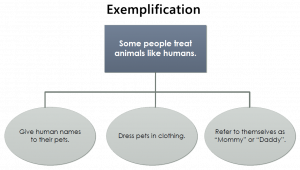Chapter 8 – Patterns of Development (Exemplification)

Exemplification
Exemplification uses one or more particular cases, or examples, to illustrate or explain a general point or an abstract concept. You have probably noticed, when on social media, watching television talk shows or listening to classroom discussions, that the most effective exchanges occur when participants support their points with specific examples. Sweeping generalizations and vague statements are not nearly as effective as specific observations, anecdotes, details and opinions. Many of the most effective essays use examples extensively. Exemplification is used in every kind of writing situation to explain and clarify, to add interest and to persuade.
It is one thing to say:
“The mayor is corrupt and should not be reelected”
and quite another to illustrate your point by saying:
“The mayor should not be reelected because he has fired two city workers who refused to contribute to his campaign fund, has put his family and friends on the city payroll and has used public employees to make improvements to his home.”
The difference? Proper and effective use of exemplification.
Here’s and example that how the primary concept is made more clear and more concrete by specific examples .

Whether we are evaluating a piece of writing or writing our own essays, exemplification can be a very useful tool in helping us better understand and communicate complicated and abstract concepts. As you have seen from the lecture, videos and reading, there are few ways to more vividly represent an idea in the minds of your readers than the proper and effective use of exemplification.
- Read this overview of Exemplification writing by Bucks County CC: Exemplification
- View this embedded video (11 Min): Exemplification Writing
Using Exemplification
Writers use exemplification extensively in every kind of writing situation to explain and clarify, to add interest and to persuade. Anytime a writer uses examples to help support or claify a point, they are using exemplification. Sometimes examples are used to help the writer develop another kind of essay (definition, comparison/contrast, cause/effect, etc.) and other times exemplification becomes the primary pattern of development for the essay itself (as with the Brett Staples essay you are reading this week).
- Download this Exemplification Worksheet. (You may use this to assist you in structuring, placing and commenting on relevant examples in your essays in ways that fully suport your overall thesis.)
Exemplification vs. Illustration
You might wonder how exemplification is different from illustration. To begin, exemplification focuses on giving examples while illustration is the broader process of making ideas clearer by using examples, diagrams or pictures. In this type of essay, examples act as supporting material to explain or clarify the generalization.
The 3 Rs of Exemplification Writing
The examples we select to illustrate a point do not need to be the only examples of the concept we are trying to define but they must be relevant, reliable and representative of that concept.
- Relevant: The examples we use must be clearly connected to the concepts we are trying to illustrate or explain. It does us no good to use irrelevant examples if we are attempting to clarify and explain an idea. Relevant examples are those which speak as directly and completely as possible to the concept they are trying to clarify or develop.
- Reliable: The examples we use to illustrate or clarify a point must be verifyable, reliable and well-supported with the appropriate academic, journalistic and/or statistical data. Often stories, memes and anecdotes are passed around (especially on social media) as examples of some idea or concept when the example didn’t actually happen or isn’t reported in a way that is accurate or reliable. In such cases, the connection between the example and that which it is being used to illustrate becomes weakened and the overall meaning of the connection is obscured.
- Representative: We must strive to make sure that our examples are not unique, isolated experiences but actually represent the larger statistical portion of the concept or idea we are trying to explore. For instance, in an essay about police brutality, it is not enough to point to one or two examples of police using inappropriate force to make the case that the problem is epidemic and rooted in the function of community policing itself. The examples must be contextualized and supported with relevant data and analysis to show how these specific examples are actually symptoms of a larger problem within police departments around the country. In another instance, a few examples of record-breaking temperatures will not, on their own, make the case for human-caused climate change but can be added to a larger research base that includes the relevant data and statistical information which gives the proper context to these figures.

